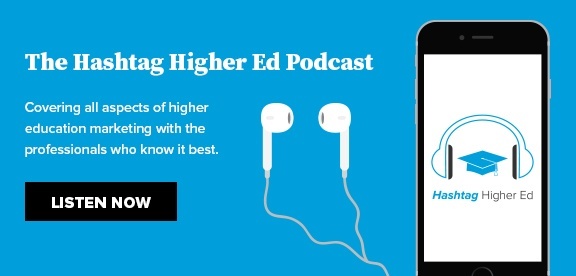Influencer marketing is a big deal these days. Consumers today, and especially young consumers, are intrinsically wary of branded content. Conversely, they are quick to relate and trust influencers who look like them.
The task for higher education then is how to lower the barriers of entry for members of your community who want to become brand ambassadors for your institution.
In our latest episode of the Hashtag Higher Ed podcast, we talk to Michelle Bartonico, the Director of Marketing & Communications at Trinity University, about how Trinity University is using brand ambassador kits, online and offline, to provide brand swag, facts and figures, and digital assets to alumni, staff, faculty, and students.
Read on, and listen in, to learn about how the idea of digital and tangible ambassador kits came to be at Trinity, the hidden benefit to Trinity’s process of requesting an ambassador kit, and how Trinity is using user-generated content and social media takeovers to extend the impact of their influencer marketing.
Michelle Bartonico on…
Making the Ambassador Kit Digital
“We know that our ambassadors are all over the world, so it’s not sustainable for us to be mailing these items everywhere. So the scope was digital first. That’s how we think as a department. It just seemed to be that most of the ways that we were asking ambassadors to engage with us as a university and with each other were digital, on social media or through ring tones; things that were easily digested online. It allows people to have the latest and greatest information and feel like they’re getting the inside scoop as quickly as anybody who is physically here on campus.”
On Trinity’s More Traditional Ambassador Kit
“It’s more custom. So if you are a teacher, and you happen to be a Trinity alum, you may visit the form, fill out a couple checkboxes, and then fill out the comments section and say ‘I teach a high school class, and we all wear size medium shirts and we need 50 of them.’ We then generally look at the request, call or email them back, and have a conversation with them. It strategically works on a lot of levels because it allows us to engage with our alums and people in the community and not just send them our stuff without any conversation or relationship-building.”
On Making Trinity University Branded Content Readily Available Online
“We’re all consumers, and so we know that we get bombarded with messages all day long. We get hundreds of emails. We’re constantly being distracted. We know that people are cluttered in terms of their mind share and where they are spending their time and energy. So as best as we can, we’re trying to put valuable information in one spot so that people can bookmark it, come back to it, and tell their friends about it very easily. We know that we’re talking to a very different audience set. We’re talking to faculty, we’re talking to parents of current students, and alumni who are all over the globe, so the more we can put everything in one spot the easier it is to communicate among those groups.”
On the Keys to Success in Influencer Marketing
“Our success in influencer marketing, I think, has come from trust. It’s come from trust that people in the Trinity community know the brand. They have positive experiences with the brand. And whether they are an alum, or a current student, or a faculty member, they have their own unique perspective and it’s one that we want them to talk about. We attempt to be as authentic as possible. I would expect [our students and alumni] to call us out if we weren’t being authentic. That’s something that motivates us.”
Michelle Bartonico’s Social Shout Outs
Jon McGee: Vice President for Planning and Public Affairs at the College of St. Benedict and St. John’s University
Follow Jon on Twitter at: @jondmcgee
“I recently read a book called “Breakpoint”, about the changing marketplace for higher education and just how the demographics are shifting there. And what needs to be recognized and then done in turn to make sure that your institution is on the forefront of innovation and survival in some sense, and Jon McGee is the author of that book.”
Rand Fishkin: Wizard of Moz, Moz.com
Follow Rand on Twitter at: @randfish
“Every Friday, I watch Whiteboard Friday, which is a video blog that Rand Fishkin puts on. They have a really good combination of SEO and content marketing and SEO is clearly their sweet spot, but I always like to stay on top of the content aspect of communication, and what it really means to be storytelling, and how that then fits into the technical aspect of it. Just because you can tell a story doesn’t mean anybody can find it. I like how Rand publishes Whiteboard Friday. It’s really easy to digest. It’s applicable. It’s consistent; you know to look for it every Friday. I always find a lot of value in checking it out.”
Nancy Duarte: CEO, Duarte
Follow Nancy on Twitter at: @nancyduarte
“Another book that I read recently is called “Illuminate.” It’s a book that talks about this type of S-curve, and where people are in their journey and brand journey. I think a lot of institutions are hovering over this point where they’re going to take a leap and create this new structure. For us, three years ago, it was creating a marketing department at Trinity. Before that, it was a public relations and communications office. We took a big leap as an institution and tried to incorporate marketing as a mind shift and a culture shift here. And so we’re on that S-curve and trying to figure out how we grow this area and make sure that we are that authentic voice for the university.”
A huge thank you to Michelle Bartonico for joining the Hashtag Higher Ed podcast. You can find Michelle on Twitter at @mlbarto, or connect with her on Linkedin.
You can listen to this episode on Soundcloud, iTunes, Google Music, or wherever podcasts are found. To explore previous episodes of the Hashtag Higher Ed podcast and sign up for alerts regarding new episodes, visit our Hashtag Higher Ed hub.




